“The dichotomy of good versus evil is bound to encounter a little bit of bickering along the way”
 We discovered the wonderful world of Jenny Clements’ webcomic Mias and Elle back at True Believers in February, and we were instantly drawn in by it’s bickering lead characters – the goody two shoes Elle and the despicably rogue-ish Mias who kidnaps her and takes her on an incredible journey. To find out more we caught up with writer/artist Jenny Clements to explore this magical world and the relationship between her two argumentative leads!
We discovered the wonderful world of Jenny Clements’ webcomic Mias and Elle back at True Believers in February, and we were instantly drawn in by it’s bickering lead characters – the goody two shoes Elle and the despicably rogue-ish Mias who kidnaps her and takes her on an incredible journey. To find out more we caught up with writer/artist Jenny Clements to explore this magical world and the relationship between her two argumentative leads!
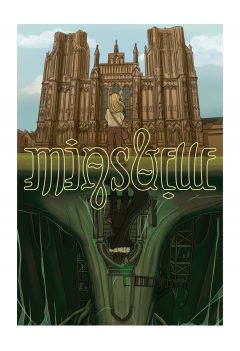 So tell us a bit about the inspiration for Mias and Elle – did you come up with the idea of these parallel worlds first or was it all about the characters?
So tell us a bit about the inspiration for Mias and Elle – did you come up with the idea of these parallel worlds first or was it all about the characters?
Jenny Clements: It started with the characters first, I thought it’d be really fun to play around with two characters who are completely opposite, one being an over the top despicable villain, the other being the sweet, caring heroine and explore the idea of how they’d both work in a relationship. Mias and Elle, in the beginning, were intentionally heavily stereotyped in their design and characteristics and that’s something that’s been diluted down after so many years, but it’s still remnant and the core of who they are. Mias was inspired by a mixture of so many movie Villains and rogues that I love; Alan Rickman’s Sheriff of Nottingham, Rowan Atkinson’s Blackadder, Dracula, Mr. Rochester, Richard III. Black eyeliner, black clothes, unashamed, unabashed, overly confident arses. And then there’s Elle; the Maiden, pure, white wearing goody two shoes, sweetheart. The perfect and natural contrast to his character.
It was always going to be set in an alternate version of Britain. My love for history, British folk lore and culture, escapism and Shakespeare wouldn’t let it be any other way. At the moment Mias’ world is heavily inspired by an Elizabethan and Jacobean aesthetic, but as the books progress there’ll be a lot more exploration into the influences of many other periods in history that have shaped British culture over the millenia.
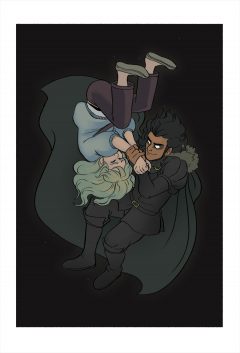 They have a great bickering relationship, was that always a key part of the story? Or did that evolve as the story progresses?
They have a great bickering relationship, was that always a key part of the story? Or did that evolve as the story progresses?
JC: A bit of both. Certainly, the dichotomy of good versus evil is bound to encounter a little bit of bickering along the way. Especially if one of my main characters is kidnapped by the other. Their bickering is part of the one aspect of their relationship that I enjoy exploring the most; just how similar they both are, despite their differences. They both believe they are in the right and are both pretty stubborn. Its so fun to explore both characters deeper stories and see why they believe they are justified in their behaviour; what makes them who they are. Plus it’s really enjoyable to write sass.
You don’t seem to be afraid to make Mias into quite an obnoxious character in the early chapters, that must have been fun to write?
JC: Extremely fun. Mias is a character who is unapologetically self assured in his choices, something I’m not, so it’s cathartic to create a character that does what he wants and is not concerned about the outcomes of his actions. I really like how he splits the audience into two as well. Some people can’t stand him and others just adore him. Each reaction is a right reaction. I feel his self confidence somewhat projects out of the page when I’m writing for him and gives me a bit of confidence about him as a good bad character to write.
He’d almost be a person you could respect, if it weren’t for the kidnap, destruction of public property, assault, irresponsible use of magic, obscenely large vegetable growing, etc.
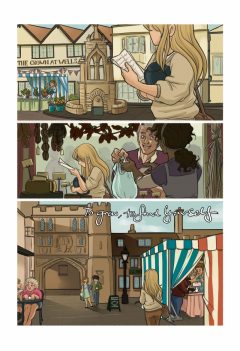 The world building is really brilliant – I love that it is set in Wells at the beginning for example? What inspired that? Is that where you’re from? I also loved the bells as a story device.
The world building is really brilliant – I love that it is set in Wells at the beginning for example? What inspired that? Is that where you’re from? I also loved the bells as a story device.
JC: From early on I knew that there would have to be a gate between Mias’ world and our own and Wells revealed itself as the answer for that. I think I visited for the first time around 2009 and not knowing much about the place I was just expecting to wonder around a pretty market town. Walking towards the end of the market there’s an Archway that leads to the Cathedral Green, and when you walk through not expecting to see this colossal honey-stoned chunk of antiquity, you can’t help but be impressed. (I suppose I’ve ruined that surprise now, sorry.) This thing is huge and important. That’s the feeling I got from it and that stuck with me. It raised so many questions that are going to be addressed in the book. Why would our ancestors build something so colossal and beautiful in this place?
Why was it so significant? All these questions flooded forward and I loved filling in the gaps with the history and the mythology I was learning about the place and creating for myself.
 I have always had a love for Cathedrals. For one they are a source for fueling my morbid curiosity. They are full of dead, important people. Shakespeare’s tomb in Holy Trinity Church has a warning curse inscribed upon it. You can stand next to dead Kings and Queens in Westminster Abbey. Stand in the spot Thomas Beckett became a martyr. Peek at relics, learn about them. Be mere inches away from these people who have been made immortal through stories. Cathedrals are these incredible time capsules. Secondly, they are stunning structures. Just beautiful and inspiring. Flipping hard to draw though. It was quite painful drawing Wells in the first chapter. So many arches. So many lines. I had regrets, but it was worth it.
I have always had a love for Cathedrals. For one they are a source for fueling my morbid curiosity. They are full of dead, important people. Shakespeare’s tomb in Holy Trinity Church has a warning curse inscribed upon it. You can stand next to dead Kings and Queens in Westminster Abbey. Stand in the spot Thomas Beckett became a martyr. Peek at relics, learn about them. Be mere inches away from these people who have been made immortal through stories. Cathedrals are these incredible time capsules. Secondly, they are stunning structures. Just beautiful and inspiring. Flipping hard to draw though. It was quite painful drawing Wells in the first chapter. So many arches. So many lines. I had regrets, but it was worth it.
The gate between the two world’s could have been any cathedral I’ve visited. I was born and raised in Cardiff so if I was feeling nostalgic I would have chosen Llandaff Cathedral as that has a lot of personal history for me, but I chose Wells mainly for how it made me react. (Plus Hot Fuzz was filmed in Wells. Wells is cool.)
There are so many pockets of quirkiness and landmarks and items of historic interest dotted around the UK that have the same significance and that have influenced the story. We have Green Men, Green Children, Witch bottles, giant White Horses on hillsides, Ghosts, hidden people, Singing horse skulls and sleeping Kings. There’s so much to take enjoyment from and I love gathering all these stories and taking influence from them.
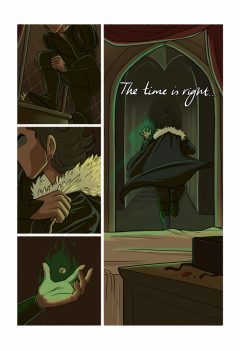 Do you find that by publishing it as a webcomic you are able to make the most of the dialogue as you aren’t restricted by page counts? Or do you still plan the story out in chapters and book sized arcs?
Do you find that by publishing it as a webcomic you are able to make the most of the dialogue as you aren’t restricted by page counts? Or do you still plan the story out in chapters and book sized arcs?
JC: Yes, not having many restrictions with the way I work means the story and the art can flow more organically. But I always try to work with each chapter being between 45-50 pages long just for consistency.
What made you start it as a webcomic? Had you worked on other comics beforehand? And does it give you a sense of freedom that traditional publishing doesn’t?
JC: I’d dabbled in comics over the years when I was a full time animator. I’d contributed to a few anthologies and made a short comic called The Moth and the Flame. Shortly after that I’d become a professional freelance storyboard artist and was working daily on turning scripts into a visual story. I loved it. It was essentially the same as making a comic, but in the industry I had worked hard to get into. The best of both worlds. After a while I just needed to jump and advance to the next logical step in my career and do what I really wanted to do, which was tell my own stories.
It would be impossible to tell my story in the animation industry as quickly as I’m telling it in a webcomic. I had an open window between jobs and that gap was quickly filled with me churning out the prologue of Mias and Elle, followed by chapter one. I’ve not looked back since. People who had been following the stories development and artwork had waited ten years, it would have been rude to make them wait longer.
 There seem to be a lot of really great female webcomic creators around at the moment, why do you think women creators seem to flourish more in the digital realm, compared to print? Is it the choice of genre or style of story perhaps? (i.e. not just following the traditional comic convention printed floppy model for publishing/story-telling)
There seem to be a lot of really great female webcomic creators around at the moment, why do you think women creators seem to flourish more in the digital realm, compared to print? Is it the choice of genre or style of story perhaps? (i.e. not just following the traditional comic convention printed floppy model for publishing/story-telling)
JC: From personal experience which doesn’t necessarily have anything to do with me being a woman, I don’t want to have to jump through hoops convincing agents or editors and comic powerhouses that the story I have to tell is worth being published. The same in my industry (which wouldn’t be brave enough to touch Mias and Elle) and why I had to leave it to make my story as I mentioned previously. It’s extremely hard convincing people there’s a market for what you want to make, but I knew I had an audience patiently waiting for the story, so just had to get on with it. Yes I’ll probably make mistakes along the way journeying down this self publishing road alone, but it’ll grow naturally and integrally. It’s a journey I welcome anyone to follow with me.
When we met at True Believers, you mentioned you are a big Patreon user and that it allows you to do this full time, which is fantastic! What’s the secret to a good Patreon?
JC: I would still be at the storyboarding (is that a pun, almost?) if it wasn’t for Patreon and my supporters on there. The timing couldn’t have been better to transition and start this project, I think I was at a huge advantage before joining patreon because I’d been working on this story for almost a decade and had gained a large following of people invested in these characters and their story. It was serendipity to put so much energy into this project and have supporters wanting to back the project as soon as I decided to focus on it full time. It’s fantastic to share the journey with my patrons too. I’m able to give them insight into the process and share ideas and thoughts about the project with them, and I love the community patreon offers. I have a personal goal to never miss a deadline for a page if I can help it. I don’t want to let my patrons down and that creates the drive to do my best by them.
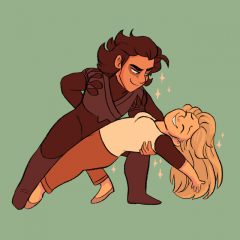 You have a beautiful art style, with a lot of animation style influences in it – who or what inspire you as an artist? I can see a lot of anime in there, but also it reminds me a lot of Kate Ashwin (Widdershins) as well.
You have a beautiful art style, with a lot of animation style influences in it – who or what inspire you as an artist? I can see a lot of anime in there, but also it reminds me a lot of Kate Ashwin (Widdershins) as well.
JC: Thank you. There have been many artists over the years that have influenced my art style, mostly artists who have worked in the animation industry and have made their own comics and visual stories. Pierre Alary, Michael Dudok de Wit, Claire Wendling, Jamie Hewlett, Alassandro Barbucchi, Juanjo Guarnido, and so many more. I’m a massive fan of Jeff Smith, Mike Mignola and Adam Warren too. All these artists have such emotion and energy in their works and I strive to get to that level. I’m less influenced by anime but my favourite film when I was a child was Laputa: Castle in the Sky. My dad taped it off the tv back in the 80’s and I remember realising that was what I wanted to do when I grew up. Tell a story like that; to create. I thought my route to doing that was animation but I realised that was not the case, but I’m so glad I was influenced to follow that road as I learnt so much about character and storytelling. I’m recently starting to appreciate the aesthetics of 70’s/80’s anime though, there is something very appealing about that less polished look. If you’d like to see the progress of my style I invite you to browse the deep dark scary depths of Deviantart (stressedjenny). It’s pretty cringy for me personally, but a great way to see a style progression that is chronologically documented over 12 years, and to look back on and take lessons from.

Am I right in thinking you hand letter? Do you work digitally for it all or is there some element of pencil and paper as well?
JC: Oh no, that’s a font of my handwriting. Everything I do is digital for the sake of time. On the course I’m on it’s going to take 25 years to tell this story so I have to be as practical with my time as I can. Which is sadly why I’ve lost the pencil and paper side of my artwork. I would have loved to render this whole comic in pencil. You can’t beat the energy and emotion in a pencil line compared to a digital one. One of two regrets about this comic. The other being that I wish I started sooner. I feel as time goes on I’m starting to find a happy balance and confidence in the digital linework. The only paper and pencil aspect of the comic is writing and thumbing (quick tiny drawings) bits of dialogue and acting. I always walk around with a little notebook in my bag as you never know when an idea or gag will pop up.
 You mentioned you are about the finish the ‘second book’ is that right – will you then be releasing that in print?
You mentioned you are about the finish the ‘second book’ is that right – will you then be releasing that in print?
JC: Yes and I’m very excited about book two, which will be the printed version of chapter three and four and also include an interlude only released on my Patreon and in a very small batch of comics, so it’ll be exciting to release that to a bigger audience and expand the world of Mias and Elle a little bit more. My deadline for the second book is the middle of April to get it compiled and printed for a May release. I’ll be at London MCM at the end of May and that will be the official book launch for the book.
And finally, after meeting you at True Believers, what conventions or events will you be heading to next? And how do you find the convention experience behind the table?
JC: This year I’ve been confirmed for London MCM in May, Cardiff Comic Con in June and Thoughtbubble in Leeds in September. I’ve got my fingers crossed for the Lakes comic festival in October too. I absolutely love the comic conventions. I used to go when I was younger and would dream of having my own stall and selling my own work and now it’s an actual part of my life and I feel so fortunate. It’s such a good feeling. The main things that gets me excited at the conventions are meeting people who know my work and hanging out with friends who I only see during the convention times. And making new ones of course. If I’m very lucky I’ll meet people who cosplay as my characters. That’s another level of happiness.
You can read Mias and Elle in full at www.miasandelle.com you can follow Jenny on twitter, instagram, Tapastic and also on Facebook.



October 8, 2025 @ 6:29 pm
Super insightful and fresh perspective. Stay with ptv sports live cricket match youtube — studio analysis and highlights. fast, reliable HD streaming. replays, expert commentary. Including highlights and social clips. works on mobile and desktop.